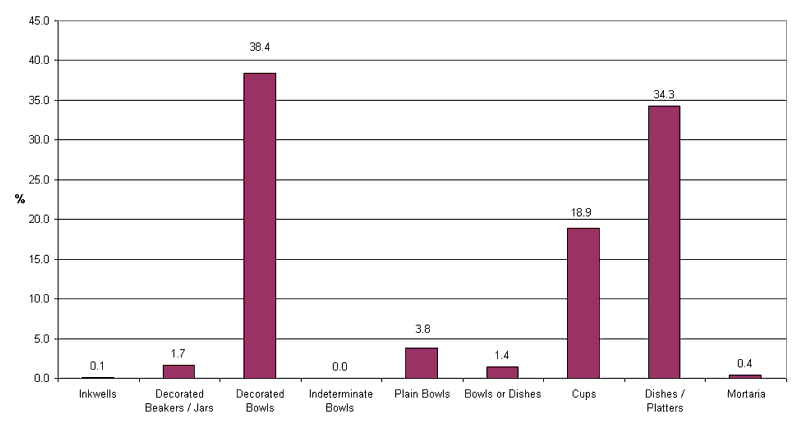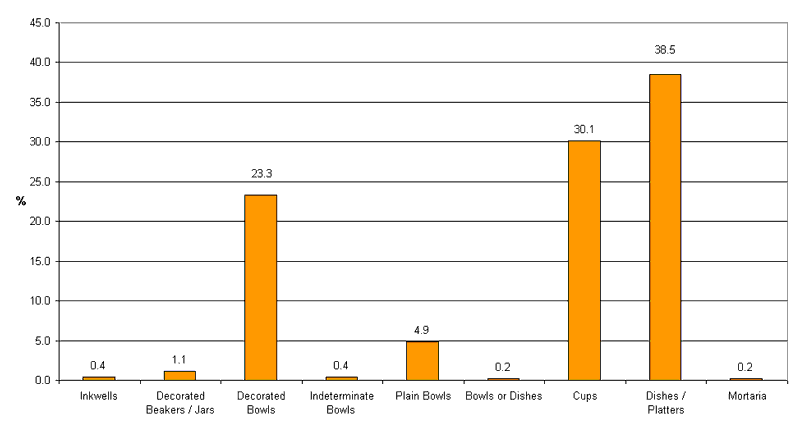
Chart 14: The Relative Frequency of Samian Form/Functional Categories at Extra-mural Occupation Sites at Roman Military Installations in Britain (Sample from 13 Dated Site Groups in database).
Chart 14 plots the relative frequency of functional types at extra-mural settlements associated with military sites. The main categories present are the same as those for military sites but in this case the emphasis is strikingly different: decorated bowls are the most common functional category, accounting for 38.4% of vessels, whereas dishes/platters form just over 34% and cups are c. 19%. A number of other functional types are recorded but again these comprise only small proportions. This remarkably high frequency of decorated vessels at vici/canabae settlements is consistent with other indicators, and has been discussed above (Section 7.3). Again this general pattern may be set alongside data from specific sites. Information on the numbers of samian forms present has been published for the vicus at Brancaster and these are summarised in Table 47 below (this sample from Brancaster is not included in the database as it was not published by phase (Hinchliffe with Sparey Green 1985)). The Brancaster vicus sample varies from the general pattern for sites of this type in so far as the proportions formed by decorated bowls and cups are much lower than in Chart 14, with contrastingly high percentages of plain bowls. This is almost certainly a function of the late date of the group, as occupation does not begin at this site until c. AD 170. Hence it is not surprising that samian mortaria (from Central and Eastern Gaul) register c. 16% of the total. The strong presence of plain bowls is of note, especially Drag. 31R (again from both Central and Eastern Gaul), with this type being a feature of late Antonine to early 3rd century groups. The comparatively low proportion formed by decorated bowls may well simply reflect the passing of time, as it appears that this form became generally less frequent in the late 2nd century (cf. Section 7.3.4).
| Source | ||
|---|---|---|
| Form Type: | Central Gaulish Lezoux | East Gaulish |
| Inkwells: 0.6% of Group | ||
| Ritt. 13 | 3 | - |
| Decorated beakers/jars: 1.2% of Group | ||
| Drag. 54 | - | 1 |
| Déch. 72 | 2 | 1 |
| Indeterminate | 2 | - |
| Decorated bowls: 12.4% of Group | ||
| Drag. 30 | 1 | - |
| Drag. 30 or 37 | 12 | 3 |
| Drag. 37 | 29 | 13 |
| Ludowici SMb/SMc | - | 2 |
| Plain bowls: 22.7% of Group | ||
| Drag. 31R | 53 | 30 |
| Drag. 38 | 3 | 9 |
| Drag. 38 or 44 | 3 | 1 |
| Curle 23 | 10 | 1 |
| Bowls or dishes: 2.7% of Group | ||
| Drag. 31 or 31R | 1 | - |
| Drag. 18/31R or 31R | 1 | - |
| Curle 15 or 23 | 11 | - |
| Cups: 8.4% of Group | ||
| Drag. 33 | 16 | 22 |
| Drag. 35 | - | 1 |
| Drag. 33 or 46 | 1 | - |
| Drag. 46 | 1 | - |
| Dishes: 33.2% of Group | ||
| Drag. 18/31R | 1 | - |
| Drag. 31 | 77 | 49 |
| Drag. 32 | - | 9 |
| Drag. 35/36 | 1 | - |
| Drag. 36 | 10 | 9 |
| Walters 79/80 | 1 | - |
| Curle 15 | 4 | - |
| Platters: 2.9% of Group | ||
| Walters 79 | 8 | 2 |
| Walters 79 or Ludowici Tg | 2 | - |
| Indeterminate | - | 2 |
| Mortaria: 15.9% of Group | ||
| Drag. 43 | - | 1 |
| Drag. 43 or 45 | - | 9 |
| Drag. 45 | 10 | 17 |
| Curle 21 | 3 | 3 |
| Indeterminate | 34 | - |
| Totals: | 300 | 185 |
| (Form not identifiable) | - | 2 |
| Aggregate totals: | 300 | 187 |
Table 47: The composition of the samian from the area of the vicus at Brancaster, Norfolk, 1974 and 1977, dated c. AD 140-260+.
Numbers record the count of vessels represented, attributable to categories; Source: Dickinson and Bird 1985.

Chart 15: The Relative Frequency of Samian Form/Functional Categories at Major Civil Centres in Britain (Sample from 40 Dated Site Groups in database).
Chart 15 shows the relative frequency of samian forms at major civil centres. In this case decorated bowls form a lower proportion of the sample than is the case with both military sites and extra-mural sites. Cups and dishes/platters each account for more than 30% or the sample. Two aspects are of interest: firstly, while dishes and platters form similar proportions at both military sites and major civil centres, the proportion formed by cups is notably higher within the sample from major civil centres; secondly, the balance of forms at major civil centres is nearer to that at military sites than it is to civil settlements outside forts (compare Charts 13,14,15).
© Internet Archaeology
URL: http://intarch.ac.uk/journal/issue17/1/8.2.3_4.html
Last updated: Mon Mar 7 2005